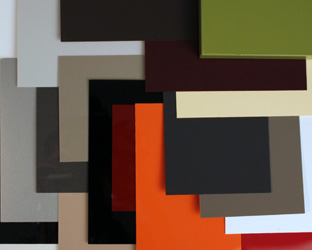In the context of interior furnishing, a laminate is a decorative layer used to cover the raw surface of a plywood, MDF, particle board or any other core material.
High pressure laminate (HPL), commonly known as ‘sunmica’ is the most conventional form of laminate which is used to decorate the surface of plywood, MDF, or particle board. HPL is made by pressing different layers of paper glued together using a phenolic adhesive, at high temperature.
Some of the other commonly used other laminate materials are veneer, glass, paper, etc.
With the advances in polymer science and technology, polymer laminates have been gradually finding their way as a material of choice for decorating furniture.
Polymer Materials
A variety of polymer raw materials are used to make polymer laminates. Some of the commonly used polymer raw materials are:
- PVC
- PETG
- HIPS
- ABS
- Acrylic
- ABS-PMMA
- ABS-PC
Please remember that not all polymer laminates are made from PVC. PVC is one of the materials which is used to make polymer laminates.
Types of Polymer Laminates
Polymer laminates can be broadly classified into two categories:
1. Polymer Films
Polymer films are ‘thin’ laminates ranging in thickness from 0.1 mm – 0.5 mm. Because they are
extremely thin, these films are readily available in roll forms. PVC, PETG are commonly used to
make polymer films.
2. Polymer Foils or Sheets
Polymer Foils or Sheets are ‘thicker’ laminates ranging in thickness from 0.6 mm to 2 mm or
more. Although polymer sheets up to 1 mm can be easily rolled, they are generally available in
‘sheet’ form. The standard size of polymer sheet is 8 x 4 feet.
PVC, HIPS, ABS, Acrylic, ABS-PMMA, ABS-PC are generally used to make polymer foils or sheets.
Advantages of Polymer Laminates
Polymer laminates offer a multitude of advantages versus the conventional laminates, such as:
* Mirror gloss (having gloss as high as 95% or more) is ONLY possible using polymer laminates.
* It’s possible to make scratch proof polymer laminates.
* They are lighter in weight than the conventional laminates
* Provides color consistency throughout the life of the laminate and also between batches
* Polymer laminates can be UV treated, thus they can be exposed to sunlight without the fear of fading color
* Materials like aryclic can be easily buffed
* Polymer laminates are very easy and economical to maintain
* Various textures, matt, and super matt finishes are easily available in polymer laminates.
* Polymer laminates can be thermo/vacuum formed, and post formed
* Polymer laminates can be recycled, thus they are environment friendly
* Polymer laminates does not emit any volatile organic contents (VOC)
Disadvantages of polymer laminates
* Requires a high level of automation to provide impeccable finish
* Requires PUR adhesive for best bonding performance
* Cannot be exposed to temperatures greater than 80C
Praveedh Décor Pvt Ltd & Polymer Laminates
We have mastered the art and science of using polymer laminates on a host of core materials. Since 2012, we are the FIRST Indian company to offer an impeccable European quality of prelaminated boards using materials like acrylic, ABS-PMMA, PETG, PVC using fully automatic flat lamination technology.
Our fully automatic flat lamination technology using German PUR adhesive ensures that all our polymer prelaminated boards are of exceptional quality and finish.
OpuLuxTM – our range of super high gloss boards is a mirror finish prelaminated on a variety of core materials like water proof plywood, MDF, and particle boards.
